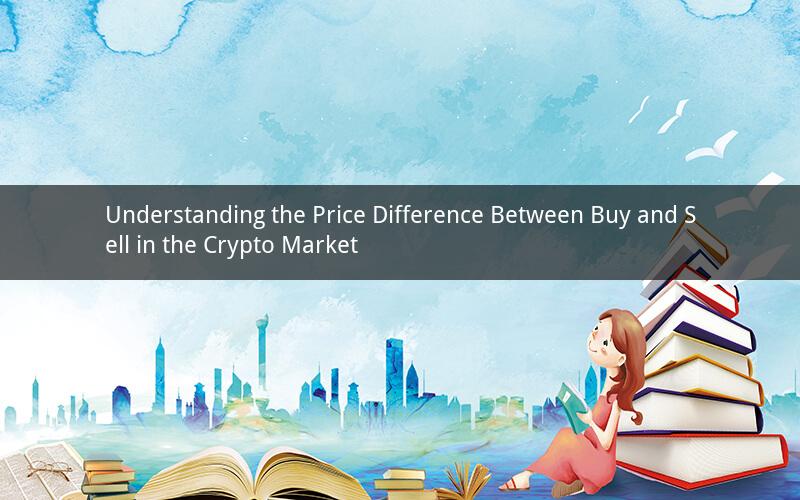
In the ever-evolving world of cryptocurrencies, one common question that often arises among investors and enthusiasts is: why is there a difference between the buy and sell prices in the crypto market? This discrepancy, often referred to as the bid-ask spread, plays a crucial role in the functioning of the market and can significantly impact traders' profitability. In this article, we will delve into the reasons behind the price difference and explore its implications for the crypto market.
1. Market Dynamics
The crypto market is characterized by its high volatility, with prices fluctuating rapidly due to various factors such as news, regulatory changes, and technological advancements. This volatility creates a dynamic environment where the buy and sell prices can differ significantly.
When a buyer enters the market, they are willing to pay a certain price, known as the bid price, to purchase a cryptocurrency. Conversely, when a seller enters the market, they are willing to sell at a specific price, known as the ask price. The difference between these two prices is the bid-ask spread.
The bid-ask spread is influenced by market dynamics, such as the supply and demand for a particular cryptocurrency. If there is high demand for a cryptocurrency, the bid price will increase, while the ask price may remain relatively stable. Conversely, if there is a surplus of supply, the ask price may decrease, leading to a wider bid-ask spread.
2. Order Execution
Another factor contributing to the price difference is the order execution process. When a buyer submits a buy order, their order is matched with a sell order at the best available price. Similarly, when a seller submits a sell order, it is matched with a buy order at the best available price.
However, the matching process may not always be instantaneous, especially during periods of high volatility. As a result, the buy and sell prices may differ due to the time it takes for orders to be executed. This delay can be further exacerbated by slippage, which occurs when the market price moves significantly between the time an order is placed and executed.
3. Market Makers and Liquidity Providers
Market makers and liquidity providers play a crucial role in maintaining a fair and efficient market by continuously providing buy and sell orders. These entities earn a profit by buying low and selling high, taking advantage of the bid-ask spread.
Market makers are typically large financial institutions or specialized firms that aim to provide liquidity to the market. They do this by continuously placing buy and sell orders at slightly different prices, ensuring that there is always a market for buyers and sellers. In return, they earn a profit from the bid-ask spread.
Liquidity providers, on the other hand, are individuals or entities that supply liquidity to the market by placing large orders. They are motivated by the potential profit from the bid-ask spread and the opportunity to earn fees from transaction fees or rebates.
4. Slippage and Transaction Costs
Slippage and transaction costs can also contribute to the price difference between buy and sell prices. Slippage occurs when the market price moves significantly between the time an order is placed and executed, resulting in a less favorable price for the trader.
Transaction costs, such as fees paid to exchanges or brokers, can also impact the price difference. These costs are typically calculated as a percentage of the transaction value and can vary depending on the exchange or platform.
5. Psychological Factors
Psychological factors, such as fear of missing out (FOMO) and herd mentality, can also contribute to the price difference between buy and sell prices. During periods of high demand, traders may be willing to pay a premium to enter the market, leading to an increase in the bid price. Conversely, during periods of high selling pressure, traders may be eager to exit the market, leading to a decrease in the ask price.
FOMO can drive the bid price higher as traders rush to buy cryptocurrencies before they become more expensive. Similarly, herd mentality can lead to a mass exodus from the market, causing the ask price to plummet.
In conclusion, the price difference between buy and sell prices in the crypto market is influenced by various factors, including market dynamics, order execution, market makers and liquidity providers, slippage and transaction costs, and psychological factors. Understanding these factors can help traders make informed decisions and mitigate potential risks.
Here are five related questions and their answers:
1. Q: Can the bid-ask spread be eliminated in the crypto market?
A: While it is challenging to eliminate the bid-ask spread entirely, certain strategies, such as using limit orders instead of market orders, can help narrow the spread and potentially reduce transaction costs.
2. Q: How can traders benefit from the bid-ask spread?
A: Traders can benefit from the bid-ask spread by taking advantage of market inefficiencies. By executing trades at favorable prices, traders can potentially increase their profitability.
3. Q: Is the bid-ask spread higher during periods of high volatility?
A: Yes, the bid-ask spread tends to be wider during periods of high volatility. This is because the market price moves rapidly, making it more challenging for traders to execute orders at desired prices.
4. Q: Can the bid-ask spread be used as a signal for market sentiment?
A: Yes, the bid-ask spread can provide insights into market sentiment. A widening spread may indicate increased selling pressure or uncertainty in the market, while a narrowing spread may suggest increased buying interest.
5. Q: Are there any regulatory measures to address the bid-ask spread in the crypto market?
A: Regulatory authorities are continuously working to address potential market manipulation and excessive bid-ask spreads. Measures such as imposing stricter regulations on exchanges and market makers can help ensure a fair and transparent market.